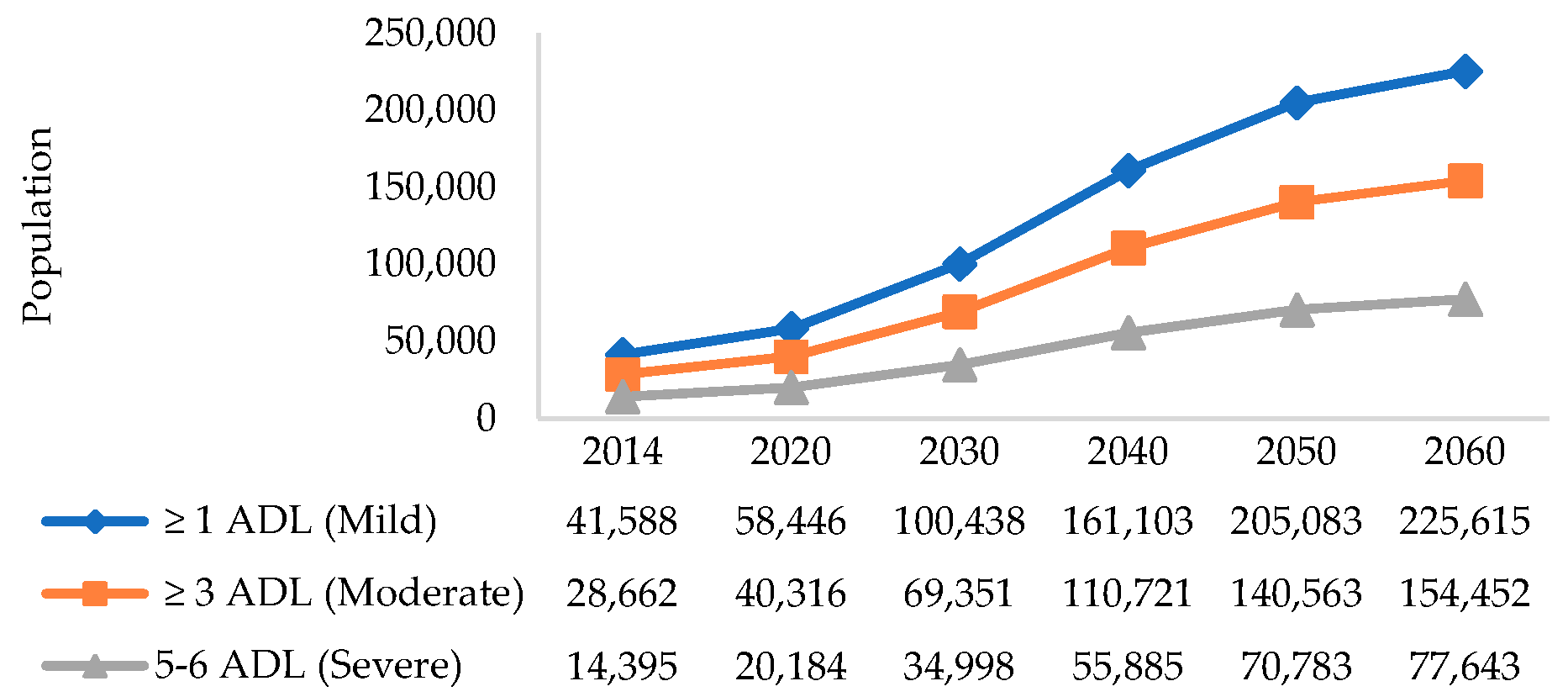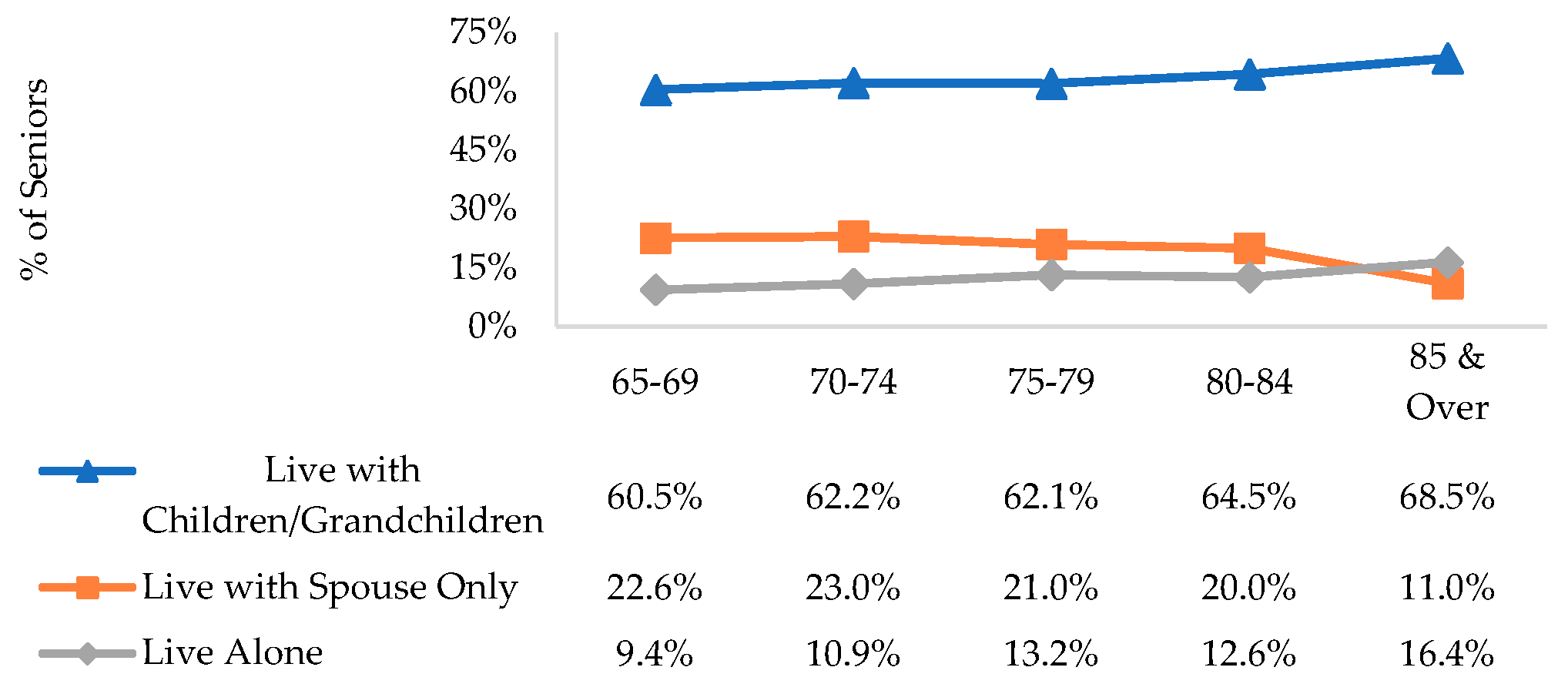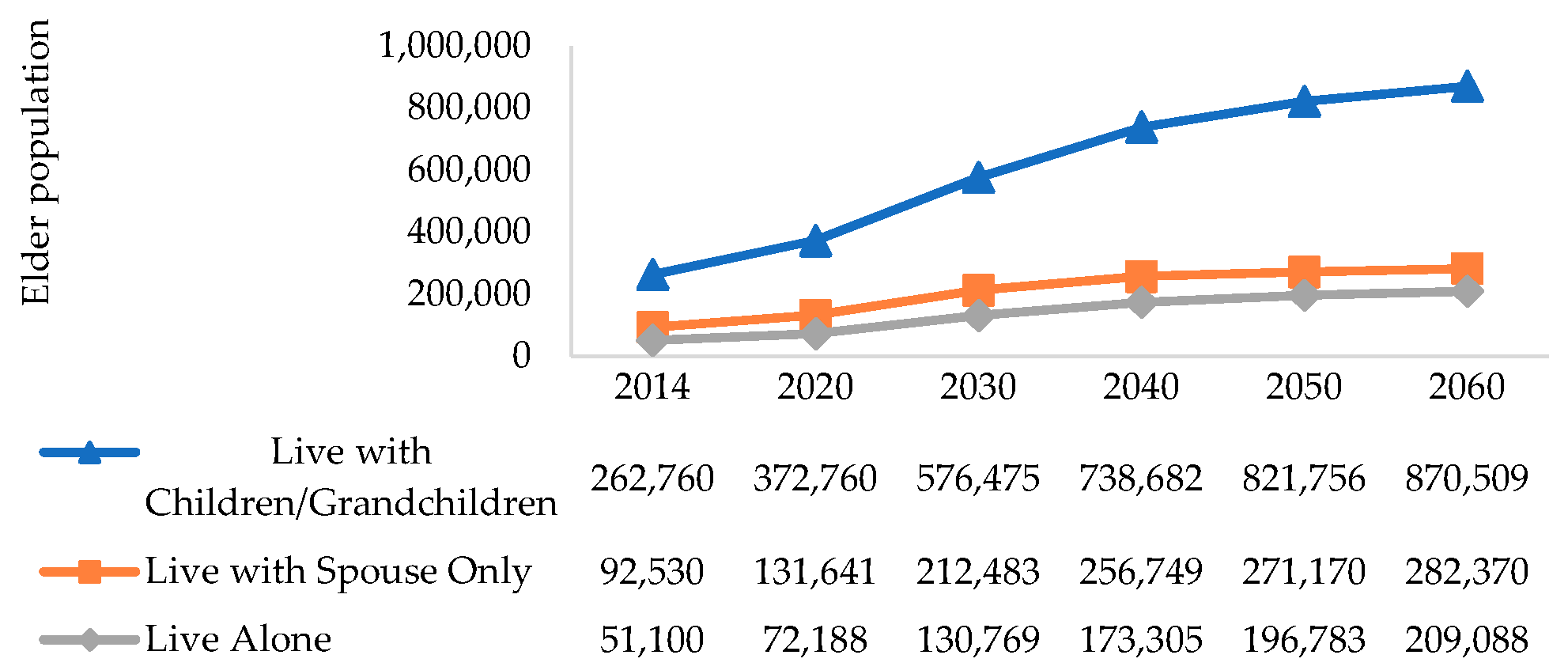40-Year Projections of Disability and Social Isolation of Older Adults for Long-Range Policy Planning in Singapore
Abstract
1. Introduction
Functional and Social Drivers of Demand for LTC Services
2. Materials and Methods
Dataset and Analytic Strategy
- Disability prevalence for 2010 and 2014 were taken from nationally representative surveys: Social Isolation, Health & Lifestyles study (SIHS) and RHS, respectively.
- To derive the age-specific proportion of seniors by living arrangements in 2034, the cohort of residents aged 45 and over in 2014 was used to form the senior cohort in 2034. We obtained the predicted living arrangements for this cohort in 2034 through ordered and multinomial logit models that achieve convergent results.
3. Results
3.1. Disability Projections
3.2. Social Isolation Projections
4. Discussion
5. Conclusions
Author Contributions
Funding
Conflicts of Interest
References
- McGinnis, J.M.; Williams-Russo, P.; Knickman, J.R. The case for more active policy attention to health promotion. Health Aff. 2002, 21, 78–93. [Google Scholar] [CrossRef] [PubMed]
- Ansah, J.P.; Malhotra, R.; Lew, N.; Chiu, C.-T.; Chan, A.; Bayer, S.; Matchar, D.B. Projection of young-old and old-old with functional disability: Does accounting for the changing educational composition of the elderly population make a difference? PLoS ONE 2015, 10, e0126471. [Google Scholar] [CrossRef] [PubMed]
- Giles, L.C.; Cameron, I.D.; Crotty, M. Disability in older Australians: Projections for 2006–2031. Med. J. Aust. 2003, 179, 130–133. [Google Scholar] [CrossRef] [PubMed]
- United Nations, D. of E. and S.A. World Population Ageing 2019: Highlights (ST/ESA/SER. A/430); United Nations Publications: New York, NY, USA, 2019. [Google Scholar]
- Biddle, N.; Crawford, H. Projections of the number of Australians with disability aged 65 and over eligible for the National Disability Insurance Scheme: 2017–2026. Australas. J. Ageing 2017, 36, E43–E49. [Google Scholar] [CrossRef] [PubMed]
- Guzman-Castillo, M.; Ahmadi-Abhari, S.; Bandosz, P.; Capewell, S.; Steptoe, A.; Singh-Manoux, A.; Kivimaki, M.; Shipley, M.J.; Brunner, E.J.; O’Flaherty, M. Forecasted trends in disability and life expectancy in England and Wales up to 2025: A modelling study. Lancet Public Health 2017, 2, e307–e313. [Google Scholar] [CrossRef]
- Alexander, B.B.; Rubinstein, R.L.; Goodman, M.; Luborsky, M. A path not taken: A cultural analysis of regrets and childlessness in the lives of older women. Gerontologist 1992, 32, 618–626. [Google Scholar] [CrossRef]
- Klijs, B.; Mackenbach, J.P.; Kunst, A.E. Future disability projections could be improved by connecting to the theory of a dynamic equilibrium. J. Clin. Epidemiol. 2011, 64, 436–443. [Google Scholar] [CrossRef]
- den Ouden, M.E.M.; Schuurmans, M.J.; Mueller-Schotte, S.; Brand, J.S.; van der Schouw, Y.T. Domains contributing to disability in activities of daily living. J. Am. Med. Dir. Assoc. 2013, 14, 18–24. [Google Scholar] [CrossRef]
- Andersen, C.K.; Wittrup-Jensen, K.U.; Lolk, A.; Andersen, K.; Kragh-Sørensen, P. Ability to perform activities of daily living is the main factor affecting quality of life in patients with dementia. Health Qual. Life Outcomes 2004, 2, 52. [Google Scholar] [CrossRef]
- Jalelah, A.B. News $200 Monthly Grant to Offset Costs of Long-Term Care Giving by End-2019: MOH. Available online: https://www.channelnewsasia.com/news/singapore/new-caregivers-monthly-grant-offset-costs-ministry-of-health-11238776 (accessed on 23 April 2020).
- Gierveld, J.D.J.; De Valk, H.; Blommesteijn, M. Living arrangements of older persons and family support in more developed countries. Popul. Bull. United Nations 2001, 43/44, 193–217. [Google Scholar]
- Ng, C.W.L.; Tan, W.S.; Gunapal, P.P.G.; Wong, L.Y.; Heng, B.H. Association of socioeconomic status (SES) and social support with depressive symptoms among the elderly in Singapore. Ann. Acad. Med. Singap. 2014, 43, 576–587. [Google Scholar]
- Lim, L.L.; Kua, E.-H. Living Alone, Loneliness, and Psychological Well-Being of Older Persons in Singapore. Available online: https://www.hindawi.com/journals/cggr/2011/673181/ (accessed on 20 July 2018).
- Ren, Q.; Treiman, D.J. Living arrangements of the elderly in China and consequences for their emotional well-being. Chin. Sociol. Rev. 2015, 47, 255–286. [Google Scholar] [CrossRef]
- Population Division, Department of Economic and Social Affairs, United Nations. Living Arrangements of Older Persons around the World; United Nations Publications: Herndon, VA, USA, 2005. [Google Scholar]
- Dykstra, P.A. The differential availability of relationships and the provision and effectiveness of support to older adults. J. Soc. Pers. Relatsh. 1993, 10, 355–370. [Google Scholar] [CrossRef]
- Hughes, M.E.; Waite, L.J. Health in household context: Living arrangements and health in late middle age. J. Health Soc. Behav. 2002, 43, 1–21. [Google Scholar] [CrossRef]
- Chen, Y.-J.; Chen, C.-Y. Living arrangement preferences of elderly people in Taiwan as affected by family resources and social participation. J. Fam. Hist. 2012, 37, 381–394. [Google Scholar] [CrossRef]
- Ng, R. Cloud computing in Singapore: Key drivers and recommendations for a smart nation. Politics Gov. 2018, 6, 39–47. [Google Scholar] [CrossRef]
- Murray, C.J.L.; Lopez, A.D. Alternative projections of mortality and disability by cause 1990–2020: Global burden of disease study. Lancet 1997, 349, 1498–1504. [Google Scholar] [CrossRef]
- Henning-Smith, C.E.; Shippee, T.P. Expectations about future use of long-term services and supports vary by current living arrangement. Health Aff. 2015, 34, 39–47. [Google Scholar] [CrossRef] [PubMed]
- Agency for Integrated Care. Available online: https://www.aic.sg/ (accessed on 23 April 2020).
- Toh, Y.C. Singapore Budget 2018: Support Network for Seniors to be Expanded. Available online: https://www.straitstimes.com/politics/support-network-for-seniors-to-be-expanded (accessed on 23 April 2020).
- Scharlach, A.; Graham, C.; Lehning, A. The “Village” model: A consumer-driven approach for aging in place. Gerontologist 2011, 52, 418–427. [Google Scholar] [CrossRef]
- Chan, L. National Electronic Patient Database Soon to Be Mandatory for Healthcare Providers. Available online: https://www.channelnewsasia.com/news/singapore/national-electronic-health-record-mandatory-clinics-9385666 (accessed on 23 April 2020).
- Ng, R.; Hiew, Y.L.; Goh, H.L.; Tan, K.B. Implementing a nationwide predictive model for frequent readmissions in Singapore public hospitals. Submitted for publication. 2018. [Google Scholar]
- Ng, R.; Allore, H.G.; Trentalange, M.; Monin, J.K.; Levy, B.R. Increasing negativity of age stereotypes across 200 years: Evidence from a database of 400 million words. PLoS ONE 2015, 10, e0117086. [Google Scholar] [CrossRef]
- Ng, R.; Lim, J. Ageism linked to culture, not demographics: Evidence from an 8-billion-word corpus across 20 countries. J. Gerontol. B Psychol. Sci. Soc. Sci. 2020. under review. [Google Scholar]
- Ng, R. OK, Boomer: Ageism in the US and UK from a pooled database of 1.1 billion words. Nature 2020. under review. [Google Scholar]
- Heidekrueger, P.I.; Sinno, S.; Tanna, N.; Szpalski, C.; Juran, S.; Schmauss, D.; Ehrl, D.; Ng, R.; Ninkovic, M.; Broer, P.N. The ideal buttock size: A sociodemographic morphometric evaluation. Plast. Reconstr. Surg. 2017, 140, 20e–32e. [Google Scholar] [CrossRef] [PubMed]
- Broer, P.N.; Juran, S.; Walker, M.E.; Ng, R.; Weichman, K.; Tanna, N.; Liu, Y.-J.; Shah, A.; Patel, A.; Persing, J.A.; et al. Aesthetic breast shape preferences among plastic surgeons. Ann. Plast. Surg. 2015, 74, 639–644. [Google Scholar] [CrossRef] [PubMed]



| Variable | Proportion 1 (%) |
|---|---|
| Age 2 | |
| 45–54 years | 5183 (41.21%) |
| 55–64 years | 4676 (32.96%) |
| 65–74 years | 3458 (17.54%) |
| 75–84 years | 1684 (7.82%) |
| ≥85 years | 102 (0.45%) |
| Gender | |
| Male | 7861 (50.60%) |
| Female | 7242 (49.40%) |
| Ethnicity | |
| Chinese | 8073 (74.85%) |
| Malay | 3455 (10.58%) |
| Indian | 2515 (8.45%) |
| Others | 1060 (6.10%) |
| Age Bands | 2010 | 2014 | ||||
|---|---|---|---|---|---|---|
| ≥Mild | ≥Mod | Severe | ≥Mild | ≥Mod | Severe | |
| 65–69 years | 4.40% | 1.81% | 1.04% | 3.27% | 2.14% | 0.95% |
| 70–74 years | 6.29% | 2.95% | 1.19% | 5.69% | 4.22% | 2.10% |
| 75–79 years | 13.14% | 6.06% | 2.36% | 9.18% | 6.38% | 3.50% |
| 80–84 years | 25.75% | 11.44% | 3.10% | 19.87% | 13.68% | 6.97% |
| ≥85 years | 50.75% | 25.19% | 10.62% | 35.02% | 23.70% | 11.77% |
| M | 13.12% | 6.09% | 2.41% | 9.63% | 6.64% | 3.33% |
| Predictor | Outcome: Living Arrangement |
|---|---|
| Odds Ratio | |
| Ethnicity | |
| Chinese | Reference |
| Malay | 2.59 *** |
| Indian | 0.94 |
| Others | 0.91 |
| Marital Status and Number of Children | |
| Single | Reference |
| Married with no Kids | 19.76 *** |
| Married with one Kid | 106.79 *** |
| Married with two or more Kids | 131.79 *** |
| Age Ranges | |
| 65–69 | Reference |
| 70–74 | 0.88 |
| 75–79 | 0.85 |
| 80–84 | 0.90 |
| 85+ | 0.92 |
| Housing Type | |
| Public Apartment (1 bedroom) | Reference |
| Public Apartment (2 bedrooms) | 3.22 *** |
| Public Apartment (3 bedrooms) | 6.53 *** |
| Public Apartment (larger than 3 bedrooms) | 9.02 *** |
| Private Condominiums | 4.56 *** |
| Landed Property | 5.99 *** |
© 2020 by the authors. Licensee MDPI, Basel, Switzerland. This article is an open access article distributed under the terms and conditions of the Creative Commons Attribution (CC BY) license (http://creativecommons.org/licenses/by/4.0/).
Share and Cite
Ng, R.; Lim, S.Q.; Saw, S.Y.; Tan, K.B. 40-Year Projections of Disability and Social Isolation of Older Adults for Long-Range Policy Planning in Singapore. Int. J. Environ. Res. Public Health 2020, 17, 4950. https://doi.org/10.3390/ijerph17144950
Ng R, Lim SQ, Saw SY, Tan KB. 40-Year Projections of Disability and Social Isolation of Older Adults for Long-Range Policy Planning in Singapore. International Journal of Environmental Research and Public Health. 2020; 17(14):4950. https://doi.org/10.3390/ijerph17144950
Chicago/Turabian StyleNg, Reuben, Si Qi Lim, Su Ying Saw, and Kelvin Bryan Tan. 2020. "40-Year Projections of Disability and Social Isolation of Older Adults for Long-Range Policy Planning in Singapore" International Journal of Environmental Research and Public Health 17, no. 14: 4950. https://doi.org/10.3390/ijerph17144950
APA StyleNg, R., Lim, S. Q., Saw, S. Y., & Tan, K. B. (2020). 40-Year Projections of Disability and Social Isolation of Older Adults for Long-Range Policy Planning in Singapore. International Journal of Environmental Research and Public Health, 17(14), 4950. https://doi.org/10.3390/ijerph17144950





